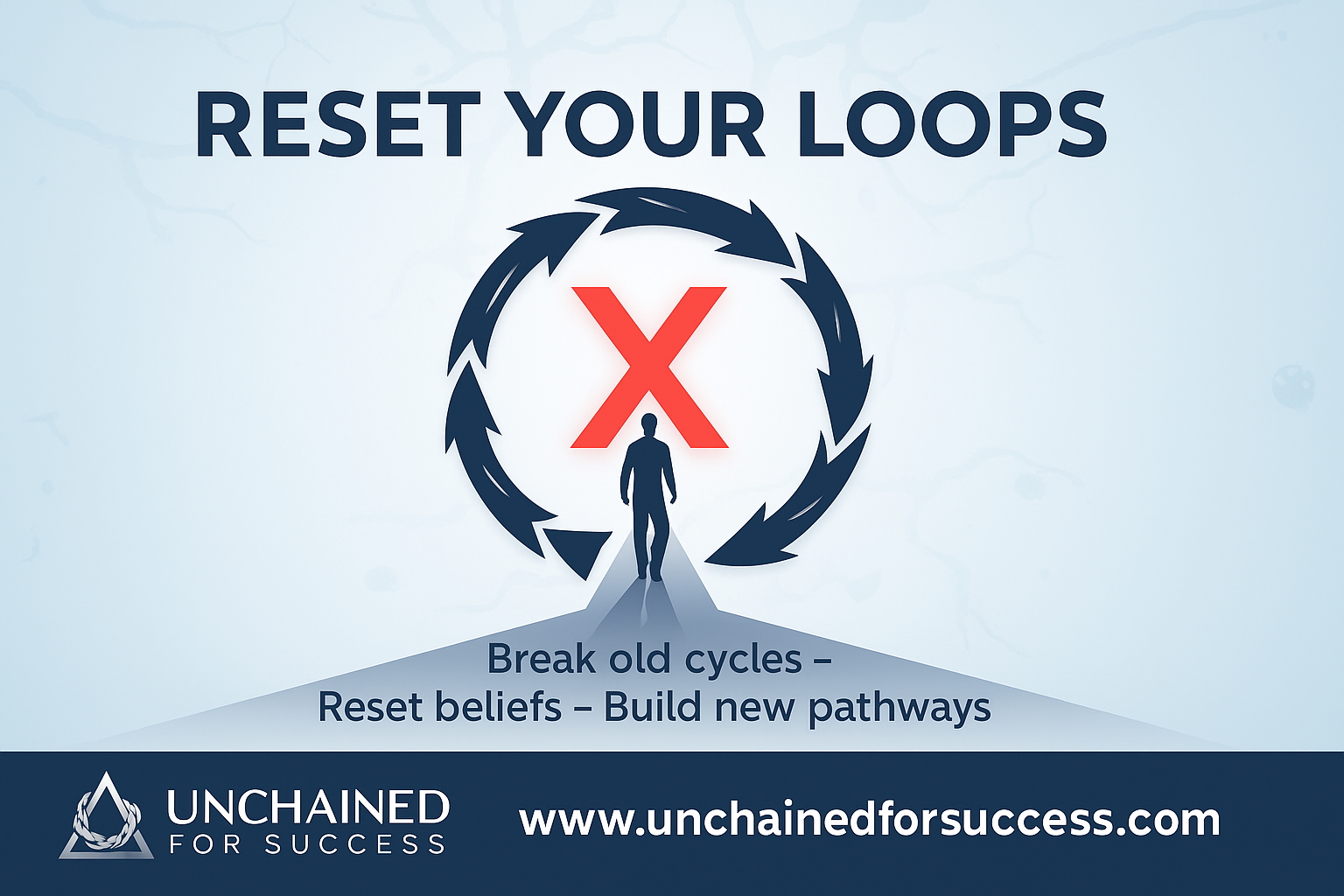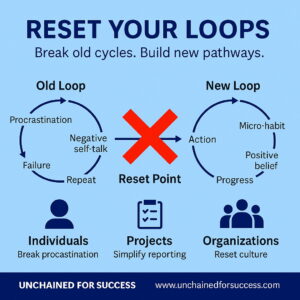Reset Your Loops: Rewire Your Brain for Breakthroughs

Introduction
Have you ever felt trapped in cycles you can’t escape? Procrastination, negative self-talk, or routines that hold you back no matter how hard you try? Neuroscience shows these patterns are more than habits — they’re loops in your brain. The good news is, you can reset your loops and deliberately rewire your brain to break free.
In 1988, doctors stumbled across a remarkable story that proved how powerful these loops are. A man with severe, treatment-resistant OCD attempted suicide with a gun. He survived — and the compulsions that had controlled his life for years disappeared. The bullet had damaged part of his brain called the basal ganglia, an area now known to regulate repetitive behaviours.
His case revealed something profound: if faulty loops can be disrupted by accident, they can also be reset by design.
This blog will show you how to reset your loops, intentionally rewire your brain, and break free from the cycles that keep you stuck — whether you are an individual seeking change, a professional striving for growth, or an organisation looking to improve performance.
The Science of Loops: Habits Are Brain Circuits, Not Just Willpower
The basal ganglia is like the brain’s habit manager. It helps us form routines that run automatically — from tying shoelaces to driving. But when these circuits malfunction, they can lock us into destructive cycles. In OCD, for example, the loop of intrusive thoughts and compulsive rituals becomes overwhelming.
The 1988 case showed that breaking this loop, even by trauma, freed the man from his compulsions while leaving his intelligence intact. Modern research confirms that our brains are full of such loops. As neuroscientist Ann Graybiel explains, habits function as “neural programmes” that run automatically once triggered.
For you, this means procrastination, avoidance, or self-doubt is not simply weakness. It’s a loop. And the encouraging truth is: you can reset your loops.
To reinforce this, Harvard Business Review’s article on the neuroscience of habits shows that everyday routines are deeply embedded in our brain’s circuitry. This makes it clear that when you choose to reset your loops, you are not just changing behaviour — you are literally changing the architecture of your brain.
How to Reset Your Loops Intentionally
You don’t need an accident to reset your loops. You can do it by design. The Goals Framework gives you the tools through Habits, Belief Engines, and Vision.
- Micro-habits
Small, repeatable actions can overwrite old loops. If you always procrastinate on big tasks, start with a two-minute rule: “I’ll do two minutes, then stop.” More often than not, you keep going. That’s loop resetting.
I explored this in detail in Micro Habits for Maximum Growth, where I showed how the smallest actions lead to exponential progress. Micro-habits are the quickest way to rewire your loops.
- Belief shifts
Loops are reinforced by belief. If you believe “I always fail,” your brain looks for evidence to confirm it. Resetting your beliefs creates new mental circuits.
In my earlier blog, Reset Your Beliefs for a Stronger Second Half, I explained how belief systems act like internal programming. Belief resets are one of the most powerful ways to reset your loops.
- Vision alignment
Your vision determines which loops you want to keep and which you want to break. Without vision, you risk swapping one bad loop for another. With vision, you direct your loops towards meaningful goals.
Practical applications:
- Individuals: Replace your evening scrolling with a five-minute walk. You reset the procrastination loop.
- Projects: Break reporting loops that waste hours by using a shared dashboard instead of endless updates.
- Organisations: Reset the loop of back-to-back meetings by instituting “focus hours” for deep work.

Practical Tools to Reset Your Loops
Here are three tools you can start using today:
- Reset Exercise
Identify one loop you want to break. Write it down: trigger → behaviour → result. Then design a replacement loop: trigger → new behaviour → positive result.
- Anomaly Log
Keep a simple journal of surprises. Each week, ask: “What opportunities hide inside these anomalies?” This trains your mind to see disruption as a chance to build new loops.
- Self-Talk Reset
Replace “I can’t” with “I’m learning to…” This subtle shift rewires loops of self-doubt into loops of growth.
Mini case study:
- Individual: A client who always skipped the gym after work identified the trigger (walking through the door at home). They reset the loop by placing trainers by the door and doing a five-minute jog first. Within weeks, the gym became automatic.
- Organisation: A company locked in a loop of punishing mistakes created a monthly “failure forum.” Staff shared what went wrong and what was learned. Innovation rose because the culture loop shifted from fear to openness.
Practical applications:
- Individuals: Choose one loop (snacking, procrastination, self-talk) and apply the reset exercise.
- Projects: Identify one “dead loop” in your project (repeated rework, endless emails) and replace it with a structured system.
- Organisations: Pick one cultural loop (blame, meetings, risk avoidance) and reset it by design.
How Do You Reset Your Loops? (FAQ)
People often ask: “How do I reset my loops?”
The answer is simple but powerful:
- Identify the loop.
- Break it with a small, deliberate action.
- Replace it with a new loop aligned with your vision.
- Repeat until the brain rewires.
It works for individuals, projects, and organisations alike.
Conclusion – Your Breakthrough Awaits
The 1988 OCD case shows that loops are real brain circuits — and they can be broken. Modern neuroscience confirms that when you reset your loops, you create new pathways that lead to different outcomes.
For you, the lesson is clear:
- Reset your loops. Break the patterns that trap you.
- Rewire your brain. Create habits and beliefs that serve your vision.
- Achieve breakthroughs. Turn what seems impossible into reality.
Call to action:
- Individuals: Download the Reset Your Loops worksheet and start today.
- Projects: Ask your team this week: “What loop can we reset together?”
- Organisations: Explore our workshop on rewiring organisational loops for performance and innovation.
Reset your loops. Rewire your brain. Achieve what others think is impossible.
References
- Kwegyir-Afful, C. Unchained: Success Unlocked (Goals Framework).
- Graybiel, A. M. (2008). Habits, rituals, and the evaluative brain. Annual Review of Neuroscience.
- Laplane, D. et al. (1989). Obsessive–compulsive disorder after damage to the basal ganglia. British Journal of Psychiatry.
- Harvard Business Review – The Neuroscience of Habits




